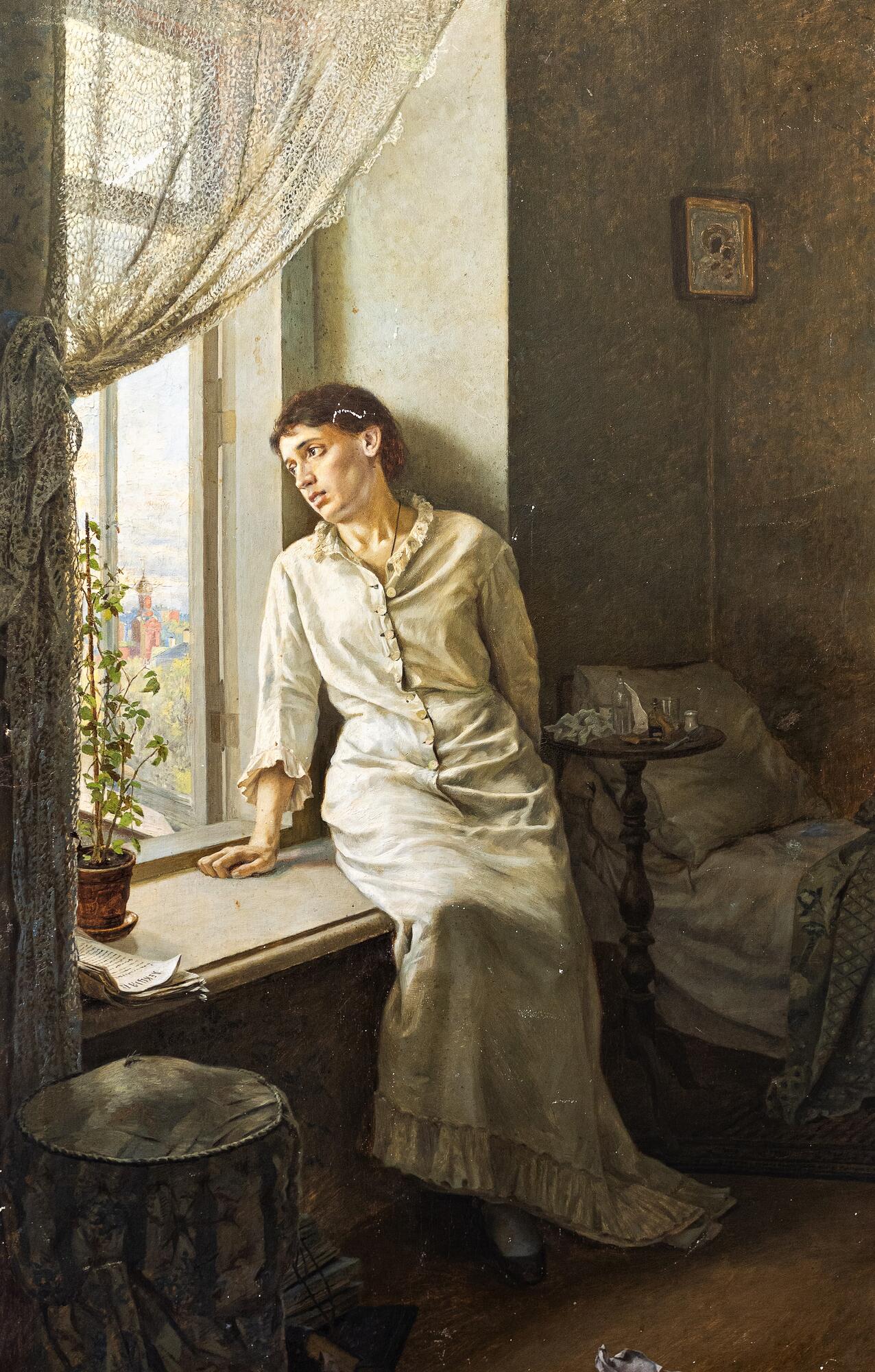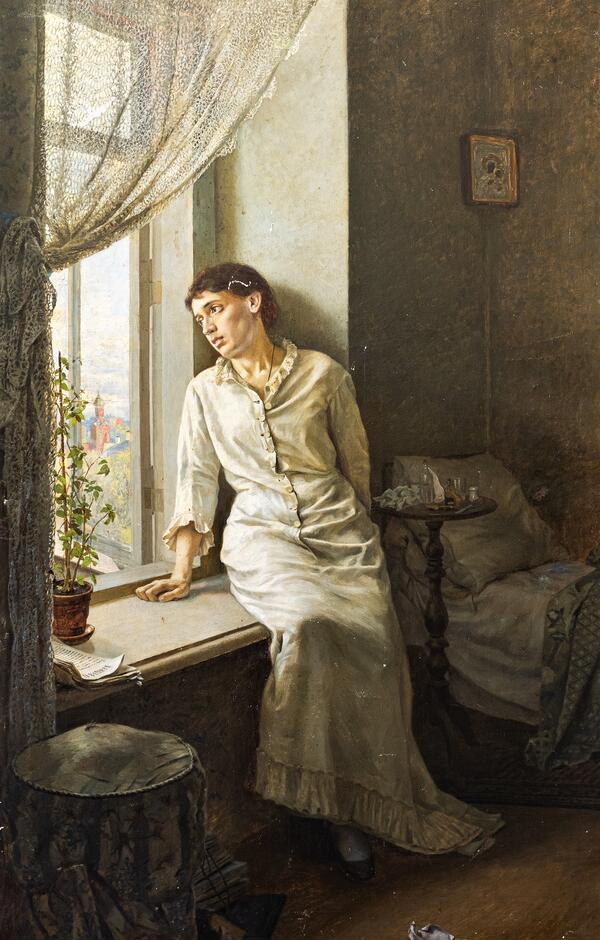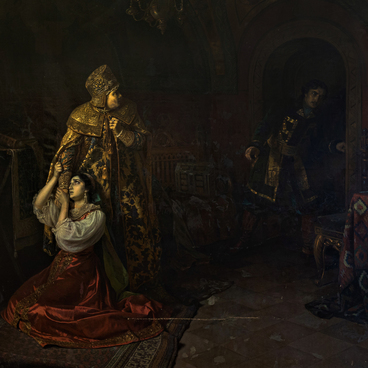The painting ‘The Last Spring’ from the collection of the art gallery of the Volsk Museum was painted by Yakov Turlygin in 1884 in a realistic style.
The canvas shows a young woman in a long white dress sitting on the windowsill in front of the open window. Bright daylight falls on her face and body, but it does not illuminate the dark gloomy bedroom.
The woman has a pale face with hollow cheeks and dull eyes. She looks sad and exhausted. There is a crumpled envelope with a red wax seal at her feet. To the right, at the back of the room, there is an unmade bed and a bedside table covered with medicine bottles. These details hint at the possibility that the girl is seriously ill and, most likely, will not recover.
One of the most common diseases of the 19th century was consumption or pulmonary tuberculosis. This disease was present within every class, whether it was ordinary factory workers, representatives of the nobility, or students. The incidence of the disease was accelerated by the humid climate, overpopulated cities, poor nutrition, and undeveloped medical care. The main symptoms of the disease were pallor, fever, prolonged cough, expectoration of blood. In neglected cases, lungs became covered with small bumps, and such patients gradually faded away.
The notes lying on the windowsill indicate that the heroine of the picture is a student. In the 19th century, it was believed that people engaged in studying or brainwork were especially susceptible to consumption. The ‘Book of Home Cures’ of the 1830s stated the following, ‘Incessant studying would destroy even the best physique… Phthisis, which occurs so often among them [scientists], comes from a bent and sitting position of the body kept for long periods.’
The artist Yakov Turlygin, who created the painting, was born on October 3, 1857, in Moscow. He graduated from the Moscow School of Painting, Sculpture, and Architecture with a large silver medal, which he received for the painting ‘Without Means of Living’. Turlygin was a painter and draftsman, worked in the historical and everyday genre, painted landscapes and pictures on biblical themes.
In 1893, he became a member of the Moscow Association of Artists, exhibited his works in the Society for Travelling Art Exhibitions. In addition to professional painting, Turlygin collaborated with comic magazines, illustrated the stories of Vsevolod Garshin and worked as a scene designer at the Lentovsky Theater. The artist died on December 17, 1909, in Moscow.
The canvas shows a young woman in a long white dress sitting on the windowsill in front of the open window. Bright daylight falls on her face and body, but it does not illuminate the dark gloomy bedroom.
The woman has a pale face with hollow cheeks and dull eyes. She looks sad and exhausted. There is a crumpled envelope with a red wax seal at her feet. To the right, at the back of the room, there is an unmade bed and a bedside table covered with medicine bottles. These details hint at the possibility that the girl is seriously ill and, most likely, will not recover.
One of the most common diseases of the 19th century was consumption or pulmonary tuberculosis. This disease was present within every class, whether it was ordinary factory workers, representatives of the nobility, or students. The incidence of the disease was accelerated by the humid climate, overpopulated cities, poor nutrition, and undeveloped medical care. The main symptoms of the disease were pallor, fever, prolonged cough, expectoration of blood. In neglected cases, lungs became covered with small bumps, and such patients gradually faded away.
The notes lying on the windowsill indicate that the heroine of the picture is a student. In the 19th century, it was believed that people engaged in studying or brainwork were especially susceptible to consumption. The ‘Book of Home Cures’ of the 1830s stated the following, ‘Incessant studying would destroy even the best physique… Phthisis, which occurs so often among them [scientists], comes from a bent and sitting position of the body kept for long periods.’
The artist Yakov Turlygin, who created the painting, was born on October 3, 1857, in Moscow. He graduated from the Moscow School of Painting, Sculpture, and Architecture with a large silver medal, which he received for the painting ‘Without Means of Living’. Turlygin was a painter and draftsman, worked in the historical and everyday genre, painted landscapes and pictures on biblical themes.
In 1893, he became a member of the Moscow Association of Artists, exhibited his works in the Society for Travelling Art Exhibitions. In addition to professional painting, Turlygin collaborated with comic magazines, illustrated the stories of Vsevolod Garshin and worked as a scene designer at the Lentovsky Theater. The artist died on December 17, 1909, in Moscow.



